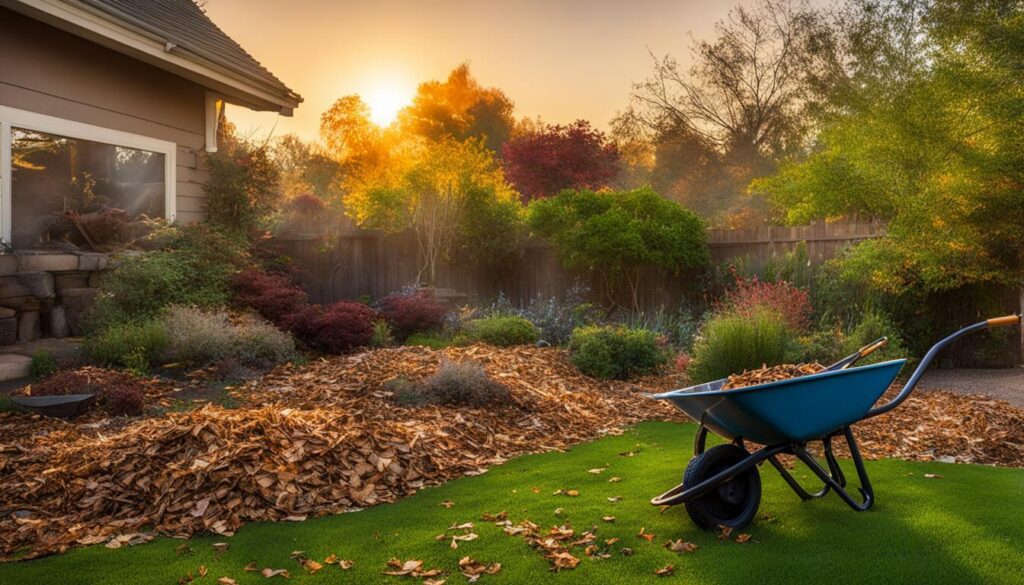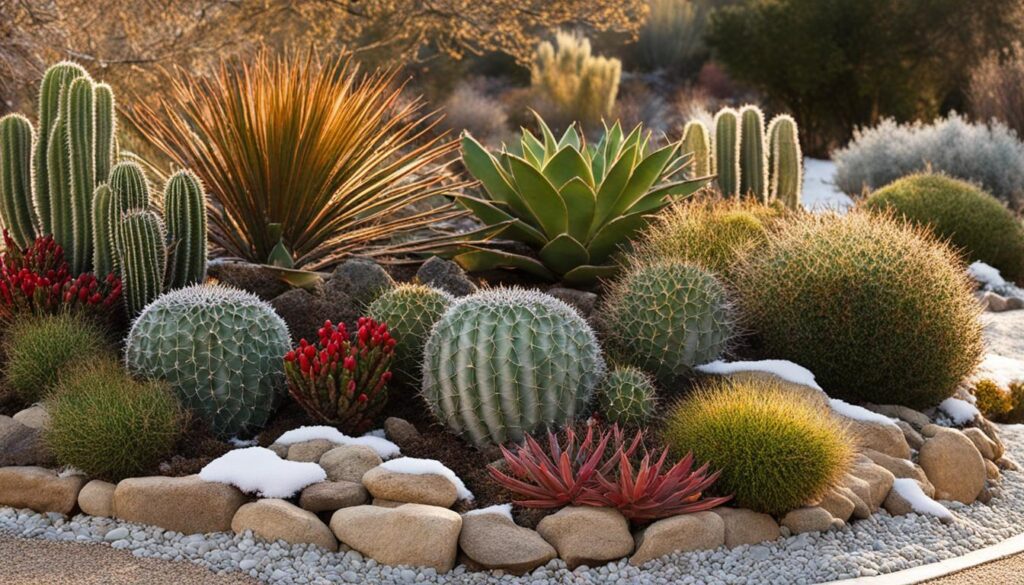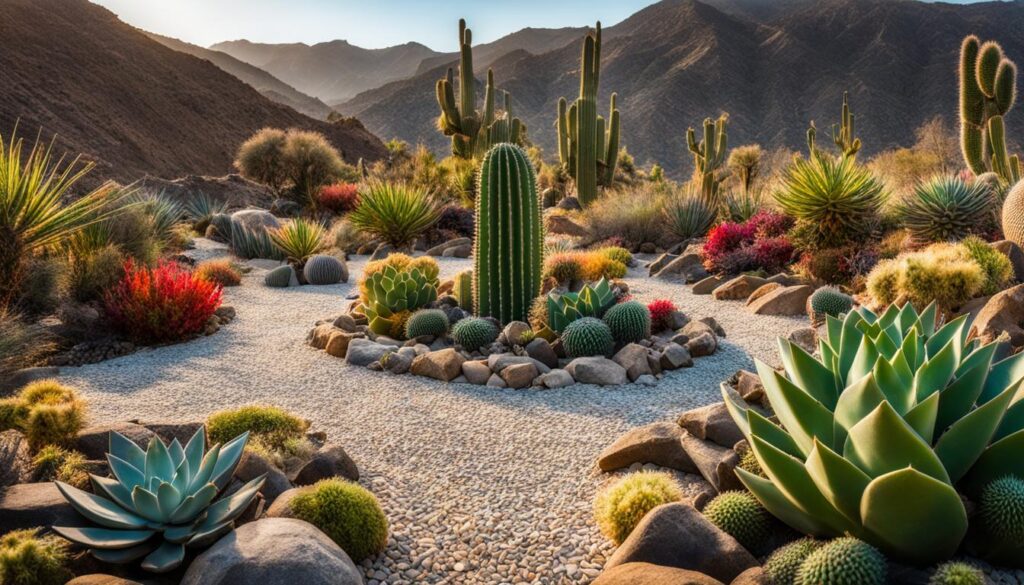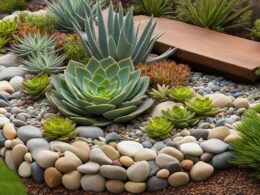Xeriscaping is a landscaping technique that uses native plants and minimal water to create low-maintenance and sustainable landscapes. While xeriscaped yards require less maintenance than traditional yards, they still need seasonal care to ensure their health and vitality. In this article, we will explore essential steps for xeriscape maintenance in the fall and winter, including clearing and cleaning, pruning and trimming, mulching and insulating, and checking and repairing drip systems. We will also discuss winter care for xeriscape landscaping, such as adjusting watering schedules, protecting plants from frost, and selecting winter-friendly plants. By following these tips, you can guarantee the health and longevity of your xeriscaped yard throughout the year.
Key Takeaways:
- Xeriscaping uses native plants and minimal water for sustainable landscapes.
- Seasonal care is necessary for the health and vitality of xeriscaped yards.
- Essential steps for fall maintenance include clearing, pruning, mulching, and checking drip systems.
- Winter care involves adjusting watering schedules, protecting plants from frost, and selecting winter-friendly plants.
- Xeriscaping saves water, reduces maintenance, and promotes sustainability.
Essential Steps For Xeriscape Maintenance In Fall
Fall is a crucial time to take care of your xeriscaped yard and prepare it for the upcoming winter. By following these essential steps, you can ensure that your landscape remains healthy and beautiful throughout the season.
Clearing and Cleaning
Start by clearing and cleaning your yard to remove any organic debris, fallen leaves, and weeds. This will help maintain the cleanliness and overall appearance of your xeriscape. Use a rake or leaf blower to gather the debris and dispose of them properly.
Pruning and Trimming
Next, prune and trim any overgrown plants to maintain their desired shape and size. This will not only enhance the aesthetic appeal of your yard but also promote healthier growth. Use sharp pruners or shears to trim away any dead or damaged branches.
Mulching and Insulating
Apply a layer of mulch around your xeriscape plants to help insulate the soil and retain moisture. Mulch acts as a protective barrier against the cold winter temperatures and helps prevent weed growth. Spread a 2-3 inch layer of organic mulch around the base of your plants, making sure to leave space around the stems to avoid moisture-related issues.
Checking and Repairing Drip Systems
Lastly, check your drip irrigation systems to ensure they are functioning properly. Inspect for any leaks, clogs, or damaged components. Make any necessary repairs or replacements before winter arrives to avoid potential water wastage and plant stress.
By following these essential steps for xeriscape maintenance in the fall, you can ensure that your xeriscaped yard remains vibrant and resilient throughout the season. Clearing and cleaning, pruning and trimming, mulching and insulating, and checking and repairing drip systems are all vital tasks that will contribute to the overall health and longevity of your xeriscape landscape. Take the time to care for your xeriscape this fall, and you’ll be rewarded with a beautiful and sustainable outdoor space.
Winter Care For Xeriscape Landscaping
Winter can be a challenging season for maintaining xeriscape landscaping, but with proper care, your plants can thrive. One important aspect of winter care is adjusting your watering and irrigation practices to accommodate reduced water needs. Xeriscape gardens are designed to be water-efficient, and in winter, the need for watering decreases even further. By reducing your watering schedule and only providing moisture when necessary, you can help prevent water waste and promote plant health.
To protect your plants from frost, it’s essential to take proactive measures. Consider covering vulnerable plants with frost blankets or cloth when the forecast calls for freezing temperatures. This simple step can help insulate your plants and prevent frost damage. Additionally, grouping cold-sensitive plants in sheltered areas can provide them with extra protection against harsh winter conditions.
Choosing winter-friendly plants is another way to ensure the success of your xeriscape garden during the colder months. Look for plants that are cold hardy and can withstand freezing temperatures. Some excellent options include yarrow, ornamental grasses, Jupiter’s beard, lavender, and curl leaf mountain mahogany. These plants not only tolerate the cold but also add beauty and texture to your winter landscape.
Implementing these winter care practices will help you maintain the health and beauty of your xeriscape landscaping even during the toughest winter months. By adjusting your watering, protecting plants from frost, and selecting winter-friendly plants, you can enjoy a thriving and sustainable xeriscape garden year-round.
Xeriscaping Landscapes: Less Is More!
Xeriscaping landscapes offer a multitude of benefits, including low-maintenance upkeep, water conservation, and sustainable landscaping. By carefully selecting native and drought-tolerant plants, using less water, and reducing the need for weekly maintenance tasks like pruning and weeding, xeriscaped yards can provide an aesthetically pleasing and eco-friendly outdoor space. While some maintenance is still necessary, it is significantly less compared to traditional landscapes. Xeriscaping embraces the philosophy that “less is more,” allowing homeowners to enjoy a beautiful and thriving yard while minimizing their impact on the environment.
When it comes to xeriscaping landscapes, one of the key principles is to prioritize water conservation. By using drought-tolerant plants that are naturally adapted to the local climate, xeriscaped yards require significantly less water than traditional landscapes. This not only helps conserve water resources but also reduces water bills and supports sustainable living. Xeriscaping also minimizes the need for excessive watering, as native and drought-tolerant plants are more resilient and can thrive with minimal irrigation.
Another advantage of xeriscaping landscapes is the reduced maintenance required. By carefully selecting plants that are well-suited to your climate and soil conditions, you can create a low-maintenance yard that requires less pruning, mowing, and weeding. Native plants typically have lower maintenance needs as they are adapted to the local environment and are more resistant to pests and diseases. This means less time spent on yard work and more time to enjoy your outdoor space.
Xeriscaping Tips:
- Choose native and drought-tolerant plants for your xeriscaped yard.
- Reduce turfgrass and opt for ground covers or mulch instead.
- Use organic mulch to retain moisture and suppress weeds.
- Group plants with similar water needs together to optimize irrigation.
- Install a drip irrigation system to deliver water directly to plant roots.
- Implement proper soil preparation techniques to improve water retention.
- Regularly monitor and adjust watering schedules based on weather conditions.
“Xeriscaping landscapes offer the perfect balance between beauty and sustainability. By embracing low-maintenance practices and water-conscious plant choices, homeowners can create stunning outdoor spaces while reducing their environmental impact.”
Xeriscaping Saves Water, Money, and Time
Xeriscaping offers significant benefits when it comes to water conservation, cost savings, and time savings. By using drought-tolerant and native plants, xeriscaped yards require little to no additional water beyond what occurs naturally. This results in reduced water usage, leading to lower water bills. Additionally, xeriscaping eliminates or minimizes the need for irrigation systems and the associated costs of maintenance and water consumption. Furthermore, the low-maintenance nature of xeriscaped yards saves time spent on watering, mowing, and other regular upkeep tasks.
Implementing xeriscaping principles not only benefits the environment but also your wallet. With reduced water consumption, you can enjoy significant cost savings on your monthly water bills. By eliminating or reducing the need for irrigation systems, you can save on maintenance costs and the resources required to keep them running. Additionally, the time saved on watering and other yard maintenance tasks can be put towards other activities or simply enjoying your outdoor space.
“Xeriscaping offers a practical solution for homeowners who want to conserve water, save money, and reduce their environmental impact.”
Overall, xeriscaping provides a practical and sustainable solution for homeowners. By embracing water conservation techniques, you can contribute to a greener environment while enjoying the numerous benefits of a beautiful and low-maintenance yard. With reduced water usage, cost savings, and time savings, xeriscaping is an excellent choice for those looking to create an eco-friendly and efficient outdoor space.
Implementing Xeriscape Design Principles
Implementing xeriscape design principles is crucial for creating and maintaining a successful xeriscaped yard. By following these guidelines, you can create a sustainable and visually appealing xeriscape landscape.
Thorough Planning
To start, thorough planning is essential when designing a xeriscape yard. Consider factors such as sunniness, shadiness, drainage, slopes, and soil conditions. By understanding these elements, you can make informed decisions about plant selection and irrigation needs.
Soil Testing
Conducting soil tests is another important step in xeriscape design. These tests help determine the moisture retention and nutrient content of the soil. This information is valuable in selecting plants that are well-suited to your specific soil conditions and can guide your watering practices.
Reducing Turfgrass
One key aspect of xeriscape design is reducing or eliminating the use of turfgrass. Grass requires more water and maintenance compared to other drought-tolerant plants. Consider replacing areas of grass with native plants, ground covers, or hardscape features.
Choosing the Right Plants
Choosing the right plants is crucial for a successful xeriscape garden. Opt for drought-tolerant and native plants that are well-adapted to the local climate. These plants require minimal water and can thrive with less maintenance. Research suitable plant varieties and choose those that complement each other in terms of color, texture, and height.
Spreading Mulch
Spreading mulch is an important step in maintaining a xeriscape garden. Mulch helps retain moisture, suppresses weeds, and moderates soil temperature. Apply a layer of organic mulch around plants, leaving a few inches of space around the stem to prevent rot.
Proper Irrigation
Proper irrigation techniques are essential for xeriscape design. Consider using drip irrigation systems that deliver water directly to the plant roots, reducing water waste. Install timers or moisture sensors to ensure efficient watering and adjust irrigation schedules based on weather conditions and plant needs.
Maintenance
Regular maintenance is necessary to keep your xeriscape garden looking its best. This includes removing weeds, pruning plants as needed, and monitoring for pests or diseases. Stay vigilant in caring for your xeriscape landscape to ensure its long-term health and beauty.
What Are the Seasonal Care Requirements for Xeriscaped Yards?
When it comes to xeriscaping maintenance best practices, keeping a xeriscaped yard looking its best year-round requires attention to seasonal care. This includes regular mulching and weeding, proper irrigation, and occasional fertilizing. In the summer months, providing extra water and shading can help prevent heat stress for plants.
The Best Plants for Xeriscaping
When it comes to xeriscaping, choosing the right plants is crucial for creating a beautiful and water-efficient landscape. Drought-tolerant and native plants are the best options, as they are naturally adapted to the local climate conditions and require minimal water. These plants have evolved to survive in arid environments, making them perfect for xeriscaped yards.
One popular choice for xeriscaping is succulents, such as aloe vera and jade plants. Succulents store water in their leaves, allowing them to thrive in dry conditions. They add a unique and eye-catching element to your landscape.
Another great option is ornamental grasses. These grasses are commonly used in hot and arid climates and are incredibly resilient. They add movement and texture to your xeriscape garden, creating a visually stunning display.
“By selecting the best plants for xeriscaping, you can create a visually stunning and water-efficient landscape that thrives with minimal maintenance.”
Other recommended plants for xeriscaping include Jupiter’s beard, lavender or rosemary, and curl leaf mountain mahogany. These plants are not only drought-tolerant but also provide vibrant colors and attractive foliage, adding interest and beauty to your xeriscaped yard.
Summary:
- Choose drought-tolerant and native plants for xeriscaping
- Succulents like aloe vera and jade plants are excellent choices that store water in their leaves
- Ornamental grasses add movement and texture to your landscape
- Consider plants like Jupiter’s beard, lavender or rosemary, and curl leaf mountain mahogany for vibrant colors and attractive foliage
By selecting the best plants for xeriscaping, you can create a visually stunning and water-efficient landscape that thrives with minimal maintenance.
Conclusion
Xeriscaped yards provide a practical and sustainable solution for homeowners who are committed to water conservation and sustainable landscaping. By implementing seasonal care and proper maintenance, you can ensure the health and longevity of your xeriscape garden.
Following the essential steps for xeriscape maintenance in the fall, including clearing and cleaning, pruning and trimming, mulching and insulating, and checking and repairing drip systems, will help prepare your yard for the upcoming winter. And don’t forget about winter care! Adjusting your watering schedules, protecting plants from frost, and selecting winter-friendly plants are crucial to ensuring the survival of your xeriscaped landscape during the toughest winter months.
Remember, xeriscaping is all about water conservation and sustainable landscaping. By embracing xeriscape design principles, choosing drought-tolerant and native plants, reducing turfgrass, and implementing proper irrigation techniques, you can create an eco-friendly and visually stunning yard that requires minimal maintenance.
So, whether you’re looking to save water, reduce your environmental impact, or simply enjoy a low-maintenance outdoor space, xeriscaping is the way to go. With the right care and attention, your xeriscaped yard will thrive for years to come, providing beauty and sustainability all in one package.














